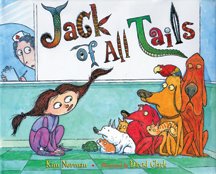 Recently, I've been discussing with writer friends about doing an author school visit with a large crowd. (Say, an auditorium full of 100-plus, even 200 kids.) So what's a children's book author to DO when faced with a large audience of eager students? Although I really enjoy the intimacy of a smaller group, most of my experience has been with larger groups, so I thought I'd toss out some advice about that:
Recently, I've been discussing with writer friends about doing an author school visit with a large crowd. (Say, an auditorium full of 100-plus, even 200 kids.) So what's a children's book author to DO when faced with a large audience of eager students? Although I really enjoy the intimacy of a smaller group, most of my experience has been with larger groups, so I thought I'd toss out some advice about that:First, you'll want to tell the school you won't do more than 30 minutes for the little guys. 45 minutes absolute MAX, but I've found that most hiring librarians agree with me that 30 minutes is enough for the little guys. We just plan longer, 45 to 60 min for the older kids. I've never had anyone insist, "Oh no. You MUST do the same amount of time for the K-Ones!"
Now, for the little kids, I have found that props and call-and-response work well... simple ones they can learn on the spot. And since Jack of All Tails is a book about pets, I make the talk more about pets than about writing. It's true that presenting to this sized group is a bit more like a performance, so for younger groups I close with "The Storytime Boogie." (That's a link to a music video of the song on YouTube.)
For props, I have a big bag from which I pull -- suspensefully, one-by-one -- stuffed animals. ("pets") Kids call out and guess what the next pet will be. We talk a bit as each animal emerges. Some of the toys are inappropriate "pets" such as crocodiles and bears. But that's just funny and we talk about what makes a good pet or not. There are always a few boys who raise their hands when I ask if anyone has a crocodile for a pet. Then we share a joke about that.
A couple of weeks ago, I presented to small groups at the Virginia Living Museum, so I handed out the pets for kids to hold as I pulled them from the bag. This seemed to really delight them. But that would probably only work with a smaller group. I've never tried it with large groups.
After the pet-bag, the stuffed animals do double duty for one of my call-and-response verses. At this point, we've read the book (on digital or overhead projector), so they know the plot. So I pick 4 kids from the audience to represent my main characters: Mom, Dad, Kristi & Eddie. I give each of them a stuffed animal to go with this rhyme:
Mom is a cat.
Dad is a dog.
Eddie's a lizard...
I'll be a frog!
And I have the "actors" hold up the animals at the appointed time, laying my hands on their heads to remind them. The audience recites it several times until they've got it down. (Of course, in the book, Kristi is never a frog, but I tell the kids, what the heck, it rhymes better than hamster!)
Once, I happened to coincidentally choose a learning disabled little girl to play Kristi, and it turned out she was visually impaired, too. The teachers were delighted I'd chosen her, since it was so good that she got a chance to touch the stuffed animal.
So mainly I'd say try to come up with things that will allow for feedback from your audience, (short of becoming chaos, of course!)
Oh, and speaking of chaos, two things:
Sometimes they DO get a little wound up as I'm pulling out the stuffed animals. To calm them down, I tell them that this or that animal gets scared by noise and they have to be verrrrry quiet when I pull out this next one.
And two:
"The Storytime Boogie." starts with a quiet lullabye. I was once hired to present at some sort of evening Reading-Pajama-rama to kids who were tired and hyped up on cocoa & marshmallows. (!!!) It was an INCREDIBLY noisy hall with an TERRIBLE sound system. I almost gave up trying to get the noise level to manageable proportions. But when I started singing that lullabye, the place just fell into an incredible hush. Holy cow! So THAT'S why mothers have been singing lullabies for so many generations!!
Kim





No comments:
Post a Comment